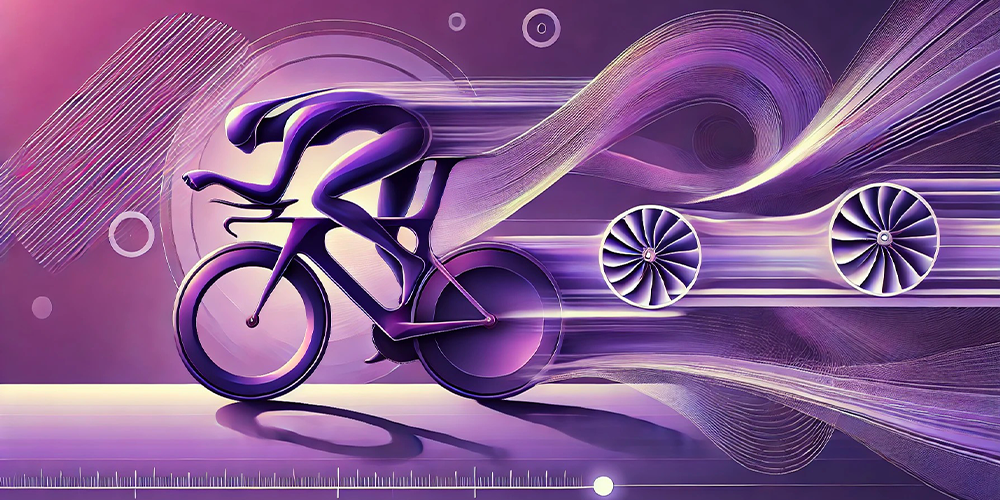When it comes to cycling, every small detail can make a difference. Aerodynamics is one of those factors that can turn a strenuous ride into a smooth and fast one. Optimizing your position and equipment to reduce air resistance will not only help you gain precious seconds but also allow you to conserve energy over long distances. Let’s explore how to improve aerodynamics on your bicycle.
1. Position on the Saddle
Your riding position is one of the most important aspects for improving aerodynamics. Even if you’re training with a high-end bike, it’s you who generates the majority of the aerodynamic drag. About 80% of the air resistance is caused by the rider themselves, with the position on the bike playing a critical role. Here are some tips:
- Lower the handlebars: Reducing the height of the handlebars allows you to assume a more inclined position, thereby reducing frontal resistance. As your speed increases, lower yourself further on the bike and use the drops to improve aerodynamics.
- Keep your elbows tucked in: By keeping your elbows close to your body, you further reduce the exposed frontal area, improving aerodynamic efficiency.
- Extend your body: Try to stretch out as much as possible on the bike, keeping your back flat and your shoulders raised forward and upward. Of course, do this without compromising comfort and your ability to pedal effectively.
- Lower your head: Keep your head in line with your body and low, without losing sight of the road ahead.
Note: Aerodynamic efficiency is important, but it loses value if you can’t maintain power. Comfort in the saddle is essential to fully express your potential.
2. Aerodynamic Equipment
Investing in specific equipment can significantly improve your performance. You don’t need to spend a fortune, but some upgrades can give you a good advantage.
- Aerodynamic helmet: Investing in an aerodynamic helmet, designed to reduce air drag, can make a big difference. Head position is crucial for improving aerodynamics, and specific helmets used both on track and road help air glide over you with less resistance.
- High-profile wheels: High-profile (or deep-section) wheels are designed to improve the bike’s aerodynamics by reducing air resistance and optimizing speed, especially on flat terrain. However, it’s important to consider that while they offer significant benefits, they can be more challenging to control in strong crosswinds. To maximize the benefits, it’s essential to pair these wheels with narrow, smooth-profile tires, maintaining proper pressure to avoid increased rolling resistance.
- Tight-fitting clothing: To optimize aerodynamics on the bike, tight-fitting clothing is crucial. Loose garments can act like a parachute, significantly slowing you down. A well-fitted jersey with tight sleeves improves the airflow around your body, reducing drag. While not everyone needs a racing suit, switching to more fitted garments can make a big difference.
3. Bike Optimization
Small modifications to your bike can significantly improve your aerodynamic efficiency.
- Reduce accessories: Carry only the essentials and reduce clutter on the handlebars. Remove unnecessary accessories, like unused light mounts, decorations, or unnecessary bags. If you use a GPS device or a main unit, make sure the mount is positioned so as not to increase air resistance. Every detail counts when it comes to reducing drag.
- Upgrade the bike: To improve aerodynamics, consider using a narrower bar or an integrated cockpit, which reduces wind resistance more effectively than a standard handlebar setup. These upgrades are a cost-effective option for optimizing performance without having to invest in a new bike.
- Maintenance: Keep your bike clean and the chain lubricated to improve aerodynamics and prevent mechanical issues. Use handlebar tape to create a smooth surface and organize any exposed cables with zip ties. A clean bike is a fast bike!
- Tilt the saddle: Slightly tilting the saddle downward can help reduce air resistance.
Conclusion
Improving aerodynamics on your bicycle is a combination of technique, equipment, and even training! Take the time to work on your riding position, improving your flexibility and endurance to maintain the ideal posture for longer. With small adjustments and some targeted investments, you can reduce air resistance and maximize your speed. Happy riding, and may the wind always be at your back!
Create with 2PEAK a triathlon, cycling, and running training plan based on artificial intelligence that adapts to your performance after each workout. Download the app and start revolutionizing your training.


